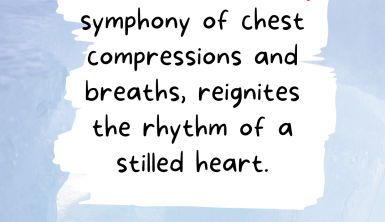What’s the difference between BLS and CPR?
The terms Basic Life Support (BLS) and Cardiopulmonary Resuscitation (CPR) are often used interchangeably.
But are there differences between the two?
The answer is absolutely, though they bear many similarities.
The American Heart Association, a decades-old organization manned by volunteers and advocates for preventing and managing heart conditions, regularly rolls rescue certification courses targeting health care workers. One such program is the basic life support class. It is very similar to lessons learned during CPR training, with a few key differences that are explored below.
What Does Basic Life Support Training Cover?
BLS can be considered as the giant umbrella under which CPR falls under. During basic life support training, students usually learn how to:
- Handle an Automatic External Defibrillator (AED)
- Complete rescue breathing techniques
- Use a bag mask apparatus to facilitate ventilation
- Clear up airways obstructions caused by choking
- Work together as a team.
What Does CPR Certification Training Cover?
Comprehensive CPR courses may sometimes teach topics that BLS certifications don’t. For example, students may opt for add-on training for:
- First-Aid techniques
- Blood pathogens
- Basic AED use
CPR Versus BLS Explained
As can be seen, basic life support covers a lot more ground than what you’d normally learn in a CPR class.
Another important difference between the two is that BLS is usually more successful when it’s performed in a team setting — and also within the confines of a hospital, where advanced medical equipment and supplies are readily available.
If, for example, maternity wing nurses needed to intubate a newborn who has stopped breathing, sterile medical tools are a must.
On the other hand, if you were to trek outside your home and saw someone under cardiac arrest, your first instinct would be to call 911 and perform CPR. In this event, only your bare hands, knowledge of the technique, and sheer will would be needed to make it happen.
Certification Prerequisites in the Health Care Field
When applying for a job in the medical field, one of the basic requirements that must be met is having a BLS certification. This is considered to be an advanced degree of CPR training, which is compulsory in most private and public medical institutions for:
- Board-certified doctors
- Emergency medical technicians
- Lifeguards
- Nurses
- Pharmacists
Certification Prerequisites in the Other Fields
Consider the above statements and now compare it with the requirements in other fields, for example. Someone who works in a daycare, babysitters, nursing home caregivers and the likes would need to furnish proof of CPR training instead of a BLS certification in most cases.
Scenario 1: How CPR is Done in Homes, at the Beach, and Other Public Places
CPR teaches students, including medical workers and non-professionals how to complete critical steps to save someone’s life during a cardiac arrest.
Chest compressions are completed in a systematic way to substitute what the heart normally does – which is to pump blood throughout the body and oxygenate vital organs.
CPR is largely performed outside of hospital settings during unexpected health emergencies. The CPR is usually executed nonstop until EMTs arrive, after which a defibrillator is applied in an attempt to shock the heart back to life.
Scenario 2: How BLS is Executed in Hospitals
Basic life support training covers distinct sets of rules for completing life-saving techniques based on the context of whom is being saved.
If it’s an infant, child, or adult, for instance, there are clear differences on what needs to be done.
CPR is similar in that you would complete rescue efforts in a slightly altered way based on the age and build of the patient. More thought processes transpire during basic life support, however, and is largely based on guidelines put forth by the American Heart Association (AHA).
Deconstructing BLS vs. CPR
To summarize, BLS is essentially a better hybrid of CPR and is predominantly studied by hands-on medical workers.
Alternatively, CPR is great for both administrative health care workers and laypersons who are interested in public health and safety.
How To Get Certified
Getting a CPR or BLS certification is easy for anyone whose interest is piqued. The National CPR Foundation offers a range of online courses that follows AHA rules. These are valid for two years and are accepted throughout the world.







